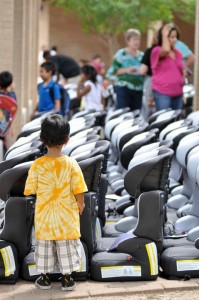 Bev Kellner has a daunting task: teaching parents how to properly buckle up their children in a child safety seat. Sounds easy enough, but considering that most of the more than 19,000 kids in car seats she’s checked over the last 14 years have been buckled improperly or not at all, she won’t be out of a job anytime soon.
Bev Kellner has a daunting task: teaching parents how to properly buckle up their children in a child safety seat. Sounds easy enough, but considering that most of the more than 19,000 kids in car seats she’s checked over the last 14 years have been buckled improperly or not at all, she won’t be out of a job anytime soon.
“Every year, there are new parents, and we will continue to teach them,” says Kellner, the manager of the Passenger Safety project at Texas A&M AgriLife Extension. “There are so many different kinds of car seats, and it’s very confusing to parents. With our National Seat Check Saturday events, we find kids either in no seat at all or in seats that are wrong for the child. Almost, without exception, every seat is improperly installed. It’s all very dangerous in the event of a crash.”
Car crashes are the leading cause of death for children. In 2009, more than 1,300 children aged 14 and younger died in motor vehicle crashes with nearly 180,000 injuries, according to the National Highway Traffic Safety Administration (NHTSA). Also reported by NHTSA — child safety seats reduce child deaths by up to 71 percent for infants and toddlers.
It’s why Kellner and other certified child safety-seat technicians are taking part in the Saturday seat checks across the country as part of National Child Passenger Safety Week, Sept. 16–22. During her Bryan, Texas, seat check event at the Brazos Center Sept. 22, technicians will be available from 8:00 to 11:00 a.m. providing one-on-one education to parents about the correct selection and installation of child safety seats. “If parents are unable to attend a seat check, they don’t have to wait until next year, and we don’t want them to,” Kellner says. “I urge them to contact a certified Child Passenger Safety Technician.” To find a technician closest to you, check out Buckleup.tamu.edu. The site lists hundreds of experts across the state.
Kellner points out that, in addition to properly restraining their children, parents should:
- Keep their child in a rear facing seat until the age of two, or until they reach 35 pounds.
- Keep their child in a 5-point harness system until they are ready for a booster seat.
- Use a booster seat after the child weighs 40 pounds and until the child is 4 foot 9 inches tall, which usually happens about age 11.
- Keep their child in the rear seat until age 13.
Coinciding with Child Passenger Safety Week, the Texas Department of Transportation began a public awareness campaign called “Save Me With A Seat” to call attention to proper child-seat installation and ensure Texas children are in the right seat for their weight and height.
Parents can find more information and view a video on proper child safety seats and their installation at http://texasclickitorticket.com/locator/index.php.